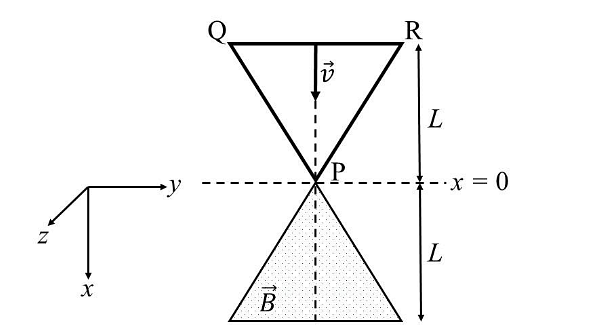A gas has a compressibility factor of 0.5 and a molar volume of 0.4 dm3 mol−1 at a temperature of 800K and pressure x atm. If it shows ideal gas behavior at the same temperature and pressure, the molar volume will be y dm3 mol−1. The value of \(\frac{x}{y}\) is ___. [Use: Gas constant, R = 8 × 10−2 L atm K−1 mol−1]
Solution and Explanation
\(V_{real}=0.4\,dm^3mol^{-1}=0.4\) L/mol
\(V_{ideal}=\frac{0.4}{0.5}=0.8\,L/mol\)
\(\therefore\,\) y = 0.8 L/mol
Using the equation PV = nRT,
P = \(\frac{1\times8\times10^{-2}\times800}{0.8}\)
x = 80 atm
\(\therefore\,\) \(\frac{x}{y}=\frac{80}{0.8}=100\)
Top Questions on Equilibrium
- The effect of addition of helium gas to the following reaction in equilibrium state, is : $PCl _5( g ) \rightleftharpoons PCl _3( g )+ Cl _2( g )$
- JEE Main - 2023
- Chemistry
- Equilibrium
- Consider the following equation: $2 SO _2(g)+ O _2(g) \rightleftharpoons 2 SO _3(g), \Delta H =-190 \,kJ$. The number of factors which will increase the yield of $SO _3$ at equilibrium from the following is _______
A. Increasing temperature
B. Increasing pressure
C. Adding more $SO _2$
D. Adding more $O _2$ E Addition of catalyst- JEE Main - 2023
- Chemistry
- Equilibrium
- The dissociation constant of acetic acid is $x \times 10^{-5}$ When $25 \,mL$ of $0.2 \,M \,CH _3 COONa$ solution is mixed with $25 \,mL$ of $0.02\, M \,CH _3 COOH$ solution, the $pH$ of the resultant solution is found to be equal to 5. The value of $x$ is ___
- JEE Main - 2023
- Chemistry
- Equilibrium
- $20 \,mL$ of $01 \,M \,NH _4 OH$ is mixed with $40\, mL$ of $005\, M \,HCl$ The $pH$ of the mixture is nearest to: (Given: $K _{ b }\left( NH _4 OH \right)=1 \times 10^{-5}, \log 2=030$, $\log 3=048, \log 5=069, \log 7=084$, $\log 11=104$ )
- JEE Main - 2023
- Chemistry
- Equilibrium
- \(K_{sp}\) of \(BaSO_4\) is 8 × \(10^{-11}\). If the solubility in presence of 0.1 M \(CaSO_4\) is?
- JEE Main - 2023
- Chemistry
- Equilibrium
Questions Asked in JEE Advanced exam
- A region in the form of an equilateral triangle (in x-y plane) of height L has a uniform magnetic field 𝐵⃗ pointing in the +z-direction. A conducting loop PQR, in the form of an equilateral triangle of the same height 𝐿, is placed in the x-y plane with its vertex P at x = 0 in the orientation shown in the figure. At 𝑡 = 0, the loop starts entering the region of the magnetic field with a uniform velocity 𝑣 along the +x-direction. The plane of the loop and its orientation remain unchanged throughout its motion.

Which of the following graph best depicts the variation of the induced emf (E) in the loop as a function of the distance (𝑥) starting from 𝑥 = 0? - Two beads, each with charge q and mass m, are on a horizontal, frictionless, non-conducting, circular hoop of radius R. One of the beads is glued to the hoop at some point, while the other one performs small oscillations about its equilibrium position along the hoop. The square of the angular frequency of the small oscillations is given by [ \(\epsilon_0 \)is the permittivity of free space.]
- JEE Advanced - 2024
- Moving charges and magnetism
- A group of 9 students, s1, s2,…., s9, is to be divided to form three teams X, Y and Z of sizes 2, 3, and 4, respectively. Suppose that s1 cannot be selected for the team X and s2 cannot be selected for the team Y. Then the number of ways to form such teams, is _______.
- JEE Advanced - 2024
- Combinations
- Let \(\vec{p}=2\hat{i}+\hat{j}+3\hat{k}\) and \(\vec{q}=\hat{i}-\hat{j}+\hat{k}\). If for some real numbers α, β and γ we have
\(15\hat{i}+10\hat{j}+6\hat{k}=α(2\vec{p}+\vec{q})+β(\vec{p}-2\vec{q})+γ(\vec{p}\times\vec{q})\),
then the value of γ is ________.- JEE Advanced - 2024
- Vector Algebra
- Let X be a random variable, and let P(X = x) denote the probability that X takes the value x. Suppose that the points (x, P(X = x)), x = 0,1,2,3,4, lie on a fixed straight line in the xy -plane, and P(X = x) = 0 for all x ∈ R - {0,1,2,3,4}. If the mean of X is \(\frac{5}{2}\) , and the variance of X is α, then the value of 24α is ______.
- JEE Advanced - 2024
- Probability
Concepts Used:
Equilibrium Constant
The equilibrium constant may be defined as the ratio between the product of the molar concentrations of the products to that of the product of the molar concentrations of the reactants with each concentration term raised to a power equal to the stoichiometric coefficient in the balanced chemical reaction.
The equilibrium constant at a given temperature is the ratio of the rate constant of forwarding and backward reactions.
Equilibrium Constant Formula:
Kequ = kf/kb = [C]c [D]d/[A]a [B]b = Kc
where Kc, indicates the equilibrium constant measured in moles per litre.
For reactions involving gases: The equilibrium constant formula, in terms of partial pressure will be:
Kequ = kf/kb = [[pC]c [pD]d]/[[pA]a [pB]b] = Kp
Where Kp indicates the equilibrium constant formula in terms of partial pressures.
- Larger Kc/Kp values indicate higher product formation and higher percentage conversion.
- Lower Kc/Kp values indicate lower product formation and lower percentage conversion.
Medium Kc/Kp values indicate optimum product formation.
Units of Equilibrium Constant:
The equilibrium constant is the ratio of the concentrations raised to the stoichiometric coefficients. Therefore, the unit of the equilibrium constant = [Mole L-1]△n.
where, ∆n = sum of stoichiometric coefficients of products – a sum of stoichiometric coefficients of reactants.



